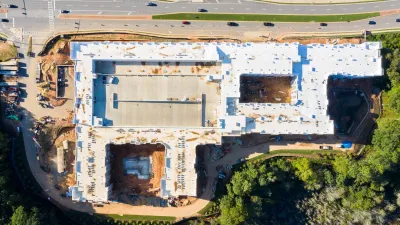Even movies set long ago and far, far away have to be filmed somewhere. With uncanny frequency, many of them, including "The Hunger Games" and "Insurgent," have been filmed in the futuristic/dystopian landscape designed by John Portman in Atlanta.

Having been rebuilt from scratch following the Civil War, Atlanta hit its stride by the 1980s, when it embraced modernist planning and modern architecture like few other American cities had. One of the poster children for urban sprawl, Atlanta built miles of freeways and built downtown towers with scant connections to the streets. Leading this modernist transformation was architect John Portman, whose signature atriums, glass elevators, and glass facades were meant to feel like cities within a city, sealed off from the chaos outside.
While urban planning has moved on from that era, Portman's apparent quest for modernity has made his buildings seem more futuristic than ever, so much so that they are frequently featured in science fiction films. The future often does not look very bright. Recently, post-apocalyptic stories including The Hunger Games: Mockingjay, Insurgent, and Interstellar have all used Portman buildings as backdrops.
Analyzing the role of Portman's work in contemporary cinema, Kristi York Wootten writes in The Atlantic:
"Filmmakers use architecture to represent societies that are forming or collapsing, and conceptual structures are too eccentric to symbolize the collective groups that dominate dystopian storylines. Portman’s work fits on film in part because his design philosophy straddles the modernism and brutalism handed down to his generation from predecessors such as Le Corbusier and Marcel Breuer, who strove to incorporate functionality and community into their buildings."
FULL STORY: How 1980s Atlanta Became the Backdrop for the Future

Maui's Vacation Rental Debate Turns Ugly
Verbal attacks, misinformation campaigns and fistfights plague a high-stakes debate to convert thousands of vacation rentals into long-term housing.

Planetizen Federal Action Tracker
A weekly monitor of how Trump’s orders and actions are impacting planners and planning in America.

In Urban Planning, AI Prompting Could be the New Design Thinking
Creativity has long been key to great urban design. What if we see AI as our new creative partner?

How Trump's HUD Budget Proposal Would Harm Homelessness Response
Experts say the change to the HUD budget would make it more difficult to identify people who are homeless and connect them with services, and to prevent homelessness.

The Vast Potential of the Right-of-Way
One writer argues that the space between two building faces is the most important element of the built environment.

Florida Seniors Face Rising Homelessness Risk
High housing costs are pushing more seniors, many of them on a fixed income, into homelessness.
Urban Design for Planners 1: Software Tools
This six-course series explores essential urban design concepts using open source software and equips planners with the tools they need to participate fully in the urban design process.
Planning for Universal Design
Learn the tools for implementing Universal Design in planning regulations.
Gallatin County Department of Planning & Community Development
Heyer Gruel & Associates PA
JM Goldson LLC
City of Camden Redevelopment Agency
City of Astoria
Transportation Research & Education Center (TREC) at Portland State University
Jefferson Parish Government
Camden Redevelopment Agency
City of Claremont





























